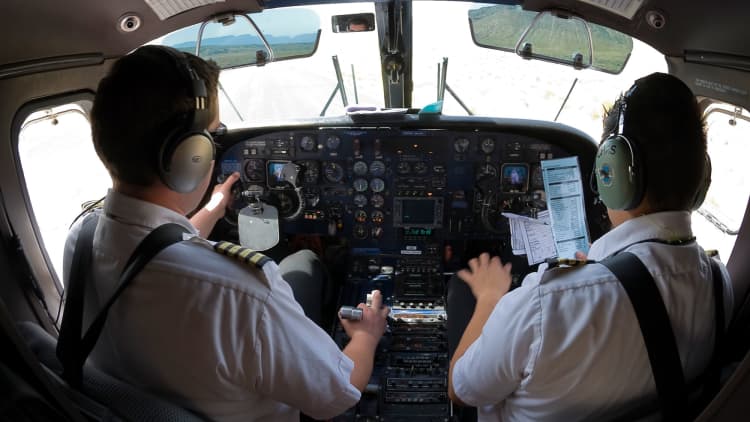How Airlines Plan To Create New Generation of Pilots Amid Fears of Decade-Long Cockpit Crisis
Even before the coronavirus pandemic grounded U.S. airlines in March 2020, a shortage of qualified pilots was looming. Today, even though air travel has come back much stronger and earlier than expected — and major carriers are returning to profitability — the struggle to maintain enough cockpit crews has developed into an acute problem that many travelers are experiencing in the form of canceled flights.
To help fix it, carriers are aggressively competing for the available pilots. Focusing more long-term, though, airlines are boosting training programs to unprecedented levels and trying to attract a younger and more diverse next generation of aviators.
According to the Bureau of Labor Statistics, there were 135,300 airline and commercial pilots employed in 2021, a number expected to grow by 6% over the next decade, translating to more than 18,000 new hires annually. As of early July, airlines had hired more than 5,500 pilots this year, already more than in any full year since at least 1990, according to Future & Active Pilot Advisors, a career consulting firm for pilots.
Baby boomers, drones and cost hit pilot profession
Pre-Covid, the supply of pilots was meeting the flying public’s demand, yet storm clouds were gathering along several fronts. The baby boomer cohort of pilots was nearing the federally mandated retirement age of 65. The rapid growth of the airline industry globally was luring U.S. pilots with better pay and perks. The traditional pathway of military pilots transitioning to civilian carriers was slowing, due to fewer deployments and the rise of autonomous drones. Meanwhile, the escalating cost (around $100,000) and time required (minimum 1,500 hours) to obtain an airline transport pilot (ATP) certificate was deterring people from entering the profession.
Then the pandemic hit. Air travel demand fell by more than 90%, leading airlines to inadvertently exacerbate the pilot shortage. To offset nose-diving revenue and reduce payrolls, they sweetened retirement deals for thousands of senior pilots. Others were furloughed or just left the profession.
“Then, when air travel bounced back faster than people had planned, and airlines started raising capacity into the marketplace, the airlines struggled to get enough pilots to meet the demand,” said Jonathan Kletzel, airline and travel practice leader at PwC. “That’s why we are where we are.”

Where the airlines are, with regard to pilots, is uncharted territory.
According to an analysis issued in August by Oliver Wyman, a New York-based management consulting firm, the industry in North America faces a shortfall of 8,000 pilots this year, or about 11% of the total workforce. That gap is estimated to grow to more than 29,000 by the end of the decade.
In late October, the firm lowered its shortage forecast a bit, “a product of the fact that regional airlines have dramatically decreased their 50-seat flying” by 50% relative to pre-Covid capacity, with more modest decreases across the sector in general, said Geoff Murray, an aviation expert at Oliver Wyman and co-author of its August report. The regionals have always been an entry point for the mainline airlines’ pilots, providing them the requisite number of hours of flight time needed before advancing.
But as those regional carriers decline, the pilot pipeline suffers, too, as do airline customers. “The pilot shortage has abated to some extent,” Murray said, “but at the expense of lower frequencies and fewer connection opportunities for travelers.” Indeed, vexing flight delays and cancellations this past summer were often blamed on a scarcity of pilots and other aviation staff.
A big reason why the regionals are suffering is that mainline carriers are poaching their pilots, especially captains who can slide directly into the co-pilot seat of the cockpit and can eventually transition to the left-seat (i.e., captains) when they have the experience and seniority. “We’ve rarely seen instances where a [major] airline will hire pilots from one of its non-affiliated regionals, and now that’s becoming mainstream,” Murray said. “It was more ruthless at the beginning of the year, but with the lower levels of regional flying now, it’s become a little more civil.”
Regional economies and small cities suffer
While airlines like United have long-term plans to increase service in smaller cities across the U.S. through advances in low-cost electric planes, a current consequence of the pilot shortage is that many small and medium-size communities serviced by the regionals are seeing their economies falter, said Helane Becker, an aviation industry analyst at Cowen. The regionals were flying 50-passenger jets into those areas, and now that their pilots are being lured away, they’ve had to cancel service. “That has huge implications for economic growth in those smaller communities,” Becker said. “In my view,” she said, speaking more generally, “in order to have a robust economy, you need a robust aviation industry.”
Although airline executives and industry observers concur that a pilot shortage exists, the Airline Pilots Association (ALPA), a McLean, Virginia-based union representing the majority of commercial aviators, maintains quite the opposite. ALPA has released a report, partly entitled “Debunking the Pilot Shortage Myth,” citing federal data to convey that the U.S. “has produced more than enough certificated pilots to meet airline hiring demands and compensate for retirements.”
The report goes on to state, “So, although we don’t have a pilot shortage, we do have a shortage of airline executives willing to stand by their business decisions to cut air service and be upfront about their intentions to skirt safety rules and hire inexperienced workers for less pay.”
ALPA declined CNBC’s requests for an interview or comments on the matter and instead provided links to the report and a press release containing updated data.




